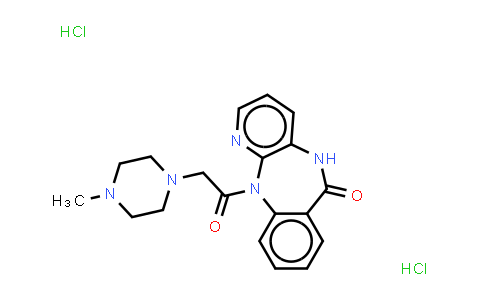
Pirenzepine (dihydrochloride) NLT 98%
SKU : MC547055
CAS Number : 29868-97-1
Molecular Formula : C19H23Cl2N5O2 | Molecular Weight : 424.32
Synonyms : LS519
Quote Request| Purity | NLT 98% |
|---|---|
| Storage | at 20ºC 2 years |
* The above information is for reference only.
* If the product has intellectual property rights, a license granted is must or contact us.
| Chemical Name | Pirenzepine (dihydrochloride) |
|---|---|
| CAS Number | 29868-97-1 |
| MDL Number | MFCD00055214 |
| Molecular Formula | C19H23Cl2N5O2 |
| Molecular Weight | 424.32 |
| Synonyms | LS519 |
Pirenzepine dihydrochloride (LS519) is a selective M1 muscarinic receptor antagonist. In Vitro: The antisecretory properties of pirenzepine on gastric acid and pepsin secretion may be attributed to the antagonistic activity of the drug on muscarinic M1 receptors of gastric intramural plexuses, whereas the effect on parietal muscarinic M2 receptors seems of less importance. Additional inhibitory mechanisms on gastric secretion may be represented by pirenzepine-induced increase in somatostatin release from gastrointestinal system. Significant cytoprotective properties of pirenzepinehave been observed on a variety of experimentally induced peptic ulcerations[1]. Pirenzepine (5-500 μg/mL) inhibits agonist-(acetylcholine-, carbachol- or nicotine-) induced contractions of the toad isolated rectus abdominis muscle, and depresses electrically provoked twitches of the rat phrenic nerve-hemidiaphragm muscle preparation[2]. In Vivo: Pirenzepine is potent in impairing learning of an avoidance; much higher doses are required to antagonize other central muscarinic effects. Pirenzepine is found to impair passive avoidance learning when given i.c.v. 20 min pre-training. The median latencies in pirenzepine-treated animals are 79.5, 11, 27 and 25.5 seconds with doses of 0.03, 0.1, 0.3 and 1 μg per mouse respectively[3]. Acid and pepsin secretion stimulated by either bethanechol or the vagus are inhibited in a dose-responsive manner by pirenzepine[4]. Pirenzepine (5-25 mg/kg i.v.) depresses indirect electrical stimulation-evoked twitches of the cat tibialis anterior and soleus muscle preparations[2].
Related Products
© Copyright 2015-2024 Hangzhou MolCore BioPharmatech Co.,Ltd. All rights reserved.
